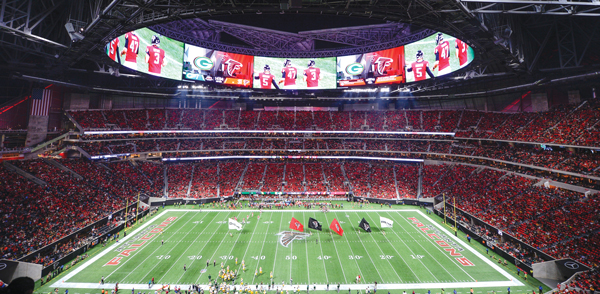 |
| All photos by: RICH VON BIBERSTEIN |
Arthur Blank sat in a suite at Mercedes-Benz Stadium, snacking on a soft pretzel on a late Friday afternoon, the day before one of the biggest weekends in Atlanta sports history: The Atlanta Falcons and Atlanta United, the two teams he owns, would play before consecutive sellout crowds of 70,000, including an MLS single-game attendance record of 70,425 for the first-year United’s game against Orlando City.
Given the delays tied to the stadium’s complex roof structure, there had been a whirlwind of activity since the facility opened in late August with prime-time college football. Early fan feedback, however, proved the wait had been worth it for AMB Group, parent company of the teams. AMB Group’s StadCo operates the publicly owned stadium.
“What I’m hearing after all these events we’ve had so far is that people cannot find someone [working at the stadium] that does not smile,” Blank said. “That’s critical because you can build a fabulous building, but if people aren’t treated right, it’s really disappointing.”
It’s fabulous, all right. The cutting-edge facility sets the bar high for design, food service and video board technology. Overall, the $1.5 billion stadium fits Blank’s vision for building an iconic structure in the country’s ninth-largest market. It also cements his commitment to the future of Atlanta, which extends to redeveloping neighborhoods just to the west of the stadium by providing job training across multiple disciplines through AMB Group’s Westside Works program.
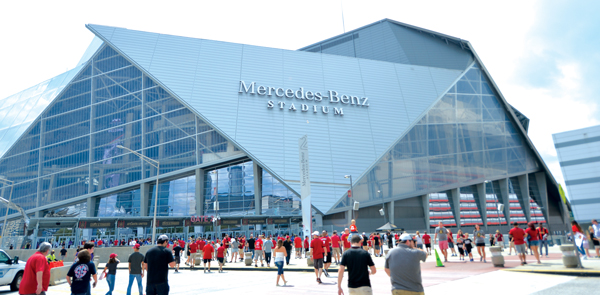 |
| The stadium’s angular design was inspired by the Falcons’ logo. |
The ambitious project pushes other teams to pursue innovation, whether it’s the stadium’s food pricing model or its video presentations on today’s monstrous boards.
“We wanted to build something iconic but we didn’t know exactly what the word meant,” Blank said. “I know the word now equals a much longer schedule and much more money. But we’re not driven by the economics. We’re driven by the right behavior and how we take care of our guests.”
To achieve that goal, AMB Group hired some key personnel three years ahead of the stadium’s opening, such as Scott Jenkins (stadium operations), Mike Gomes (fan experience) and Jared Miller (technology). In addition, project officials got Levy’s director of operations, Brian Lapinskas, who ran the food at the Georgia Dome next door, involved well in advance. The same was true for Michael Drake, who spearheaded Legends’ premium-seat sales campaign, later hired internally by AMB Group as a senior vice president and chief revenue officer.
“Hiring those people so early in the process … that’s not something I saw on other projects,” said Drake, who sold premium seats for AT&T Stadium and Levi’s Stadium before moving to Atlanta.
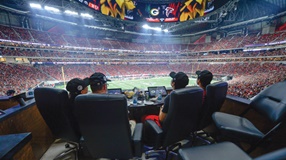 |
| Loge box overlooking the field. |
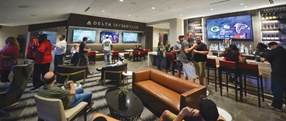 |
| Fans gather in the Delta Sky360 club. |
They joined others, such as AMB Sports and Entertainment Chief Commercial Officer Tim Zulawski, in his 15th year with the team, to help program a stadium they all feel has delivered a higher level of customer service, fan engagement and sponsor activation.
It all starts with the halo board attached beneath the roof, which supplies the wow factor for fans first entering the seating bowl. The board is massive. If stood up straight, the 1,110-foot-long screen would surpass the height of the Bank of America Plaza, Georgia’s tallest building.
“We were captivated by it from the beginning,” said Rich McKay, the Falcons’ president and CEO, of the Daktronics technology.
The board grew bigger as the roof structure expanded over time. Four years ago, as part of its initial presentation, sports architect HOK (then 360 Architecture) showed up with a stadium model featuring an octagonal video board embedded in the roof. As digital technology advanced and curved screens became a trend, the board evolved into a smooth oval shape, giving video board producers the ability to display images seamlessly across the entire screen, giving it an even more striking role in game presentation.
“That was probably one of the best decisions we’ve made, because I believe that they’ve only just begun to explore what they can do with that thing,” said Bill Johnson, HOK’s senior vice president and the project’s design principal.
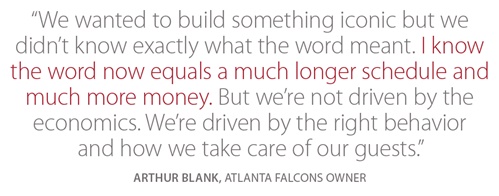
The retractable roof itself is a work of art. The roof’s eight “petals” open and close with a motion similar to a camera lens, setting it apart from other stadiums with less imaginative movable roofs.
“As an industry, we got stuck in a rut with retractable roofs,” Johnson said. “I’d always thought, couldn’t we do this completely different, so the roof was beautiful and when it opened there was this element of surprise and discovery … a spectacle. It was all about that.”
But there’s something to be said for simplicity, and the immense weight of those moving parts was among the factors that slowed the project down, resulting in a six-month delay for opening the stadium. As of last week, it took about 90 minutes for the roof to open; the goal over time is to reduce the process to 10 minutes, AMB Group CEO Steve Cannon said. The organization took a risk, but in the end, it’s paid off with a striking design, which includes the roof as well as the sharp angles of the walls forming the stadium’s exterior, designed to look like a falcon’s wings.
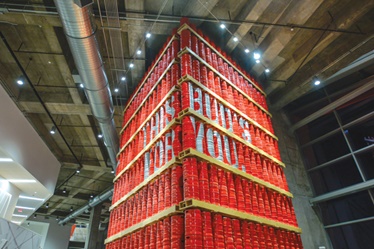 |
| The color of both the Falcons and Budweiser, form the centerpiece for the Budweiser Biergarten |
“Arthur Blank wasn’t overly impressed with the existing football venues we have in the U.S.,” Johnson said. “He wanted something different. We had this idea about the energy of the building being right at the center. We love the Falcons logo … a cool bird with edgy wings and lots of triangles, so let’s make the building kind of look like that. Plus, Atlanta is a modern city and the buildings around us are sleek and glass with a contemporary feel, and this city needs an icon from its sports facilities.”
Inside the building, Gomes, the stadium’s senior vice president of fan experience and a former Disney executive, oversaw concourse development, such as the Budweiser Biergarten and the 100-Yard Club, which is on the upper concourse on the 300 level and typically open for Falcons games only.
Both are heavily branded public spaces. On the 100 level, the biergarten’s centerpiece, a giant wall of stacked Bud kegs painted red, marks the brewer’s real estate, joined by a concession stand selling Bud-infused cheese fries. A Bud-branded bar sitting at the edge of the lower bowl completes the package. It’s one of nine four-sided bars in the building branded for alcoholic beverages with views to the game.
The biergarten is Gomes’ favorite area of the stadium because it folds all aspects of activation into one place with directional signs, graphics, food and beverage, plus artwork and lighting, part of a holistic design approach. Too often, those elements are jammed together in one space, Gomes said.
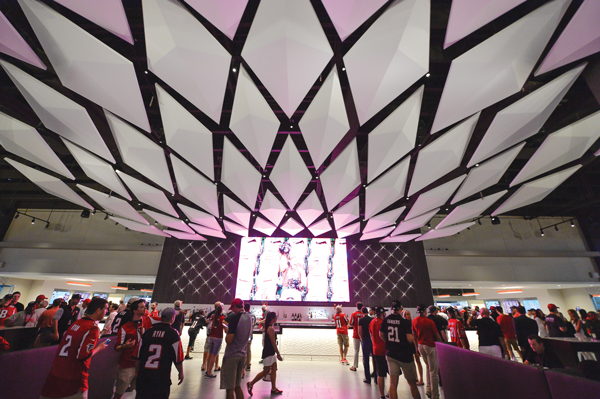 |
| The Mercedes-Benz Club is among the premium lounges at event level. |
“It helps because Bud also has red in their color palette,” he said. “We were conscious from an interior design perspective to make sure everything was consistent across the board, from the materials and looks to the lighting at each of the bars.”
The 100-Yard Club, as the name implies, stretches 100 yards on the south end of the 300 level concourse. The floor markings and overhead lighting correspond to the yard lines and hash marks on the field. It’s bookended by Redd’s Apple Ale and Miller Lite “red zone” bars. In between, structural columns are branded for individual Falcons stars such as Alex Mack, Matt Ryan, Devonta Freeman and Desmond Trufant, part of the team’s broader strategy to help “unmask our players with personal stories,” Gomes said. The 100-Yard Club is an early fan favorite and was packed shortly before kickoff of the Falcons’ regular-season home opener Sept. 17.
| Project cost |
$1.5 billion |
| Area |
2 million square feet |
| Owner |
Georgia World Congress Center |
| Operator |
AMB Group |
| Tenants |
Atlanta Falcons, Atlanta United, Chick-fil-A Peach Bowl |
| Architects |
HOK, tvsdesign, Goode Van Slyke Architecture, Stanley Beaman & Sears, Johnson Studios, Cooper Carry |
| General contractor |
Holder Hunt Russell Moody |
| Structural engineer |
BuroHappold Engineering |
| Owner's representative |
Darden & Co. |
| Graphics designer |
Dimensional Innovations |
| Seating |
71,000 |
| Sales agency |
Legends Global Sales |
| Suites |
191 ($125,000 to $400,000 a year, 16 to 22 seats) |
| Club seats |
7,500 ($3,550 to $3,850 a person a year) |
| Loge boxes |
28 (four-seat boxes, all-inclusive, average of $90,000 a year) |
| PSLs sold |
58,500, ($500 to $45,000) |
| Naming rights |
Mercedes-Benz |
| Founding partners |
American Family Insurance, AT&T, Coca-Cola, Equifax, Georgia Power, Home Depot, IBM, NCR, Novellis, Scana Energy, SunTrust Bank |
| Concessionaires |
Levy, Concentrics Restaurants (Molly B's) |
| Retail |
Fanatics |
| Technology |
AT&T (Wi-Fi), Daktronics (video boards), IBM (integrator), NCR (point-of-sale) |
Source: AMB Group, SportsBusiness Journal research
Most of the premium lounges are situated at field level, which presents operational challenges, said Jenkins, the facility’s general manager. About 7,000 club seat patrons and those holding tickets to the Touchdown Suites navigate the same hallways as the players, media and game-day staff. The stadium’s basement has essentially become its own concourse, and getting people downstairs from the 100 level concourse and to the appropriate clubs without disrupting the players’ path to and from the field is something that will have to work itself out over time, Jenkins said.
The Falcons bypassed the trend of NFL teams passing through the middle of field-level clubs from the locker room to the field. Instead, the team walks past the Mercedes-Benz Club, separated by a glass wall, and enters the field through a tunnel in the southwest corner. (Atlanta United walks through the Delta Sky360 Club on the north sideline). That decision was made after the Falcons went through an “uncomfortable” experience walking through a club space as the visiting team in their first trip to AT&T Stadium after it opened in 2009, McKay said.
“We went in it once and our head coach [the since-departed Mike Smith] said we’re never going back through it again,” he said. McKay would not provide details, but the Falcons now use a tunnel in Arlington to avoid the club and he feels the tunnel system works best for the team at Mercedes-Benz Stadium.
As a result of that decision, the Mercedes-Benz Club is designed differently from the Delta Sky360 Club. The main bar sits in the center of the hospitality space compared with the Delta club’s bar spaces, which are split in two for United players to walk through.
Both sideline clubs are roomy and encompass about 20,000 square feet. They open to the field with patio and drink rail space extending between the 20-yard lines, which expands upon similar layouts at the Cowboys and 49ers stadiums as field-level spaces continue to evolve in the NFL.
“We think field clubs were great, but why aren’t people building them between the 20s?” Drake said. “We made ours much bigger. Arthur was going to spend what it took to leave his legacy here and said, ‘Absolutely,’ when we approached him about expanding those spaces.”
In Atlanta, the “club within a club” concept is tied to more exclusive lounges off to the side of the two primary clubs. They’re branded for AMG, Mercedes-Benz’s high-performance division, and SunTrust Bank. The smaller clubs both measure about 10,000 square feet.
Apart from sports, the clubs were designed to host private events on non-game days such as weddings and board meetings, where speakers can plug their presentations into the big screens attached to the club walls, Jenkins said.
For Blank, the stadium fits into his life’s work: sports, his co-founding of Home Depot and his charitable efforts, which have recently extended to matching up to $1 million in donations collected by the Red Cross to assist Hurricane Harvey victims in Houston.
“Whether it be fans, guests, customers, whoever … we’re making people happy and making a difference in their lives, and that’s the greatest source of satisfaction for me personally,” he said. “That’s not a transaction … that’s a life’s journey.”










